engine coolant MAZDA MODEL 3 HATCHBACK 2005 (in English) User Guide
[x] Cancel search | Manufacturer: MAZDA, Model Year: 2005, Model line: MODEL 3 HATCHBACK, Model: MAZDA MODEL 3 HATCHBACK 2005Pages: 322, PDF Size: 4.7 MB
Page 240 of 322

Black plate (240,1)
Owner Maintenance Schedule
The owner or a qualified service technician should make these vehicle inspections at the
indicated intervals to ensure safe and dependable operation.
Bring any problem to the attention of an Authorized Mazda Dealer or qualified service
technician as soon as possible.
qWhen Refueling
lBrake and clutch fluid level (page 8-18)
lEngine coolant level (page 8-16)
lEngine oil level (page 8-14)
lWasher fluid level (page 8-21)
qAt Least Monthly
Tire inflation pressures (page 8-31)
qAt Least Twice a Year (For Example, Every Spring and Fall)
lAutomatic transaxle fluid level (page 8-20)
lPower steering fluid level (page 8-19)
You can do the following scheduled maintenance items if you have some mechanical
ability and a few basic tools and if you closely follow the directions in this manual.
lAir filter (page 8-23)
lEngine coolant (page 8-16)
lEngine oil (page 8-14)
8-10
Maintenance and Care
Owner Maintenance
Mazda3_8T97-EC-04J_Edition1 Page240
Saturday, September 25 2004 2:16 PM
Form No.8T97-EC-04J
Page 242 of 322
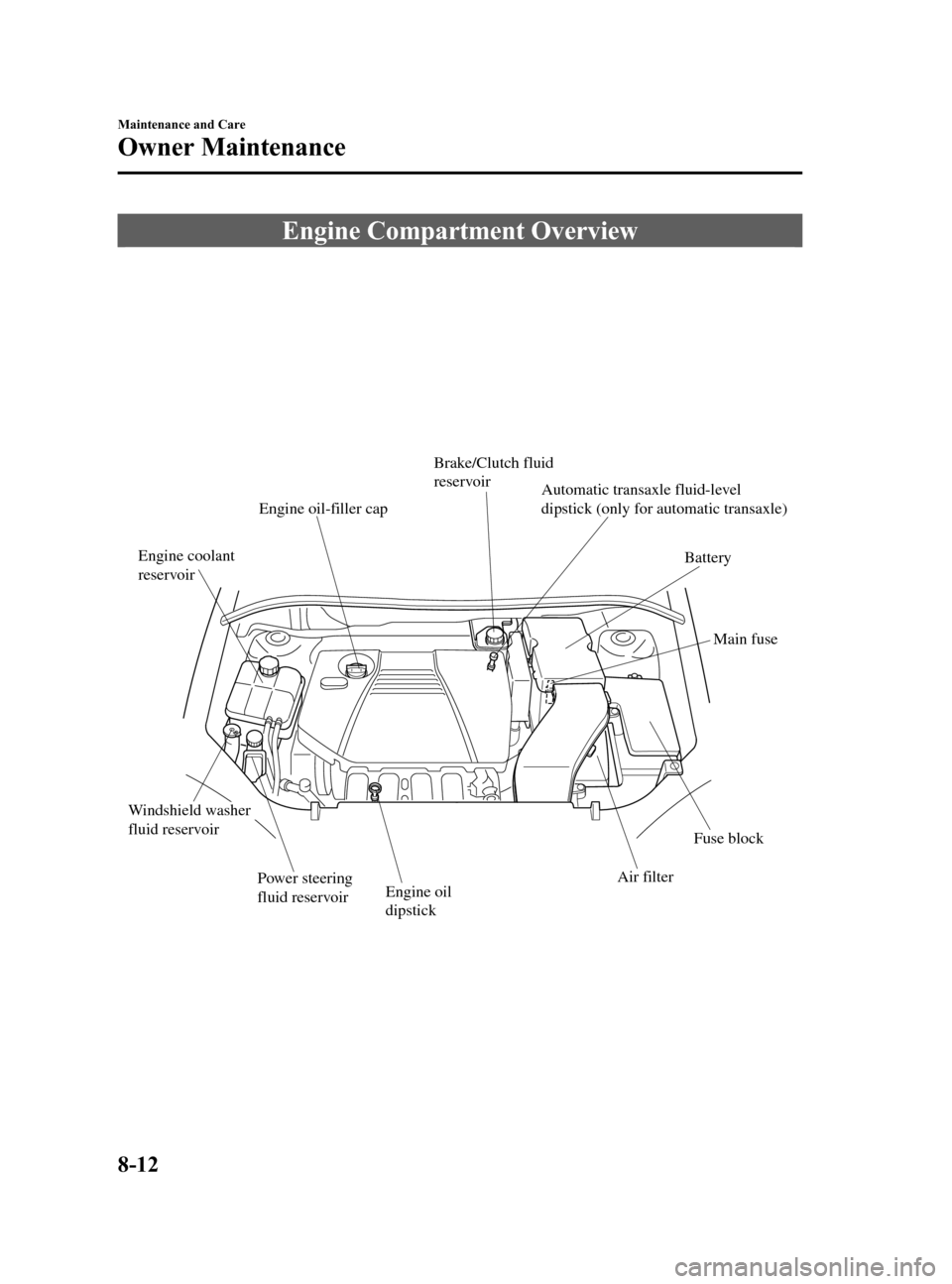
Black plate (242,1)
Engine Compartment Overview
Engine oil
dipstick
Fuse block
Air filter
Battery
Brake/Clutch fluid
reservoir
Engine oil-filler cap
Engine coolant
reservoir
Windshield washer
fluid reservoir
Power steering
fluid reservoir
Main fuse
Automatic transaxle fluid-level
dipstick (only for automatic transaxle)
8-12
Maintenance and Care
Owner Maintenance
Mazda3_8T97-EC-04J_Edition1 Page242
Saturday, September 25 2004 2:16 PM
Form No.8T97-EC-04J
Page 246 of 322
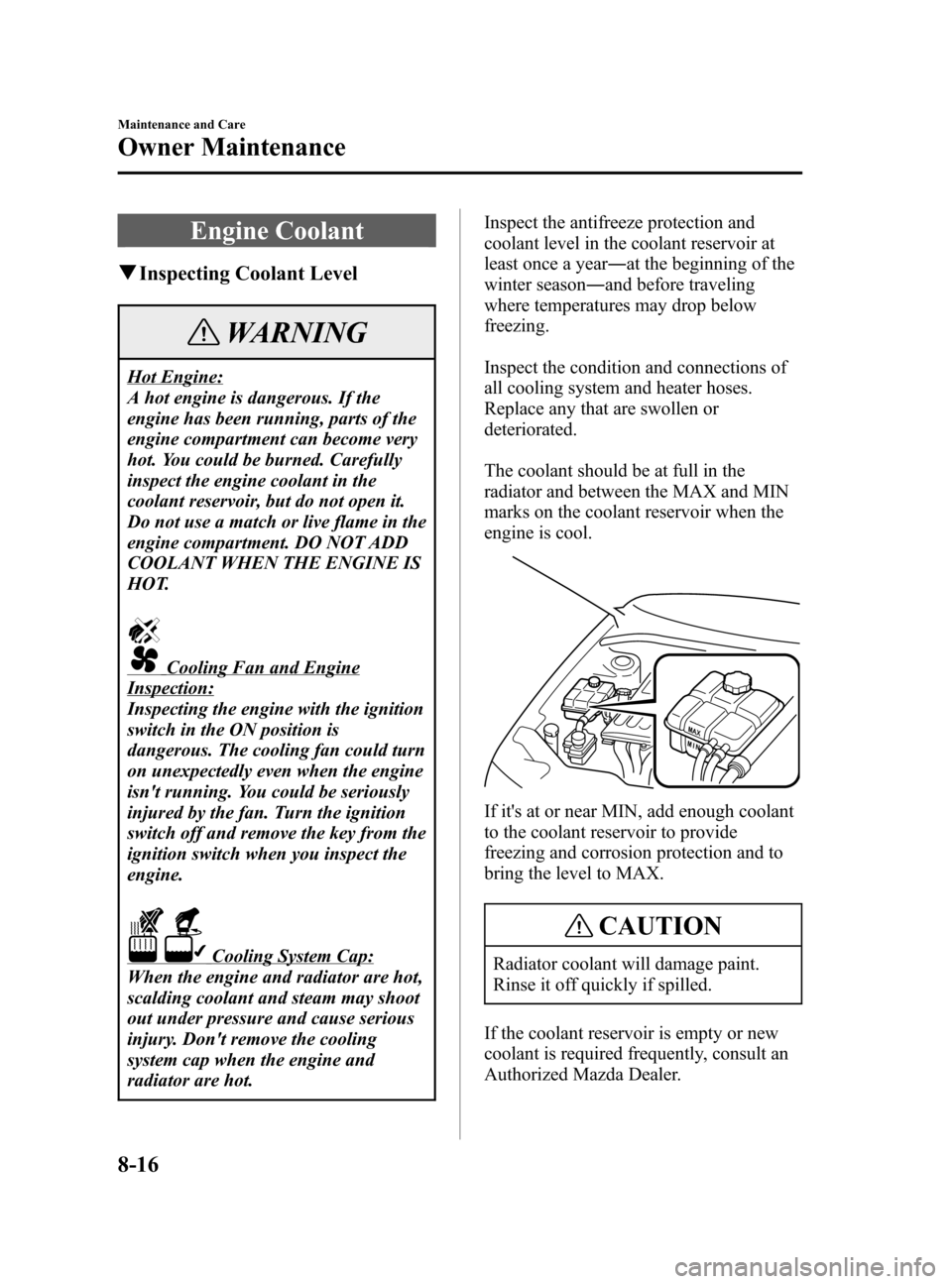
Black plate (246,1)
Engine Coolant
qInspecting Coolant Level
WARNING
Hot Engine:
A hot engine is dangerous. If the
engine has been running, parts of the
engine compartment can become very
hot. You could be burned. Carefully
inspect the engine coolant in the
coolant reservoir, but do not open it.
Do not use a match or live flame in the
engine compartment. DO NOT ADD
COOLANT WHEN THE ENGINE IS
HOT.
Cooling Fan and Engine
Inspection:
Inspecting the engine with the ignition
switch in the ON position is
dangerous. The cooling fan could turn
on unexpectedly even when the engine
isn't running. You could be seriously
injured by the fan. Turn the ignition
switch off and remove the key from the
ignition switch when you inspect the
engine.
Cooling System Cap:
When the engine and radiator are hot,
scalding coolant and steam may shoot
out under pressure and cause serious
injury. Don't remove the cooling
system cap when the engine and
radiator are hot.Inspect the antifreeze protection and
coolant level in the coolant reservoir at
least once a year―at the beginning of the
winter season―and before traveling
where temperatures may drop below
freezing.
Inspect the condition and connections of
all cooling system and heater hoses.
Replace any that are swollen or
deteriorated.
The coolant should be at full in the
radiator and between the MAX and MIN
marks on the coolant reservoir when the
engine is cool.
If it's at or near MIN, add enough coolant
to the coolant reservoir to provide
freezing and corrosion protection and to
bring the level to MAX.
CAUTION
Radiator coolant will damage paint.
Rinse it off quickly if spilled.
If the coolant reservoir is empty or new
coolant is required frequently, consult an
Authorized Mazda Dealer.
8-16
Maintenance and Care
Owner Maintenance
Mazda3_8T97-EC-04J_Edition1 Page246
Saturday, September 25 2004 2:16 PM
Form No.8T97-EC-04J
Page 247 of 322
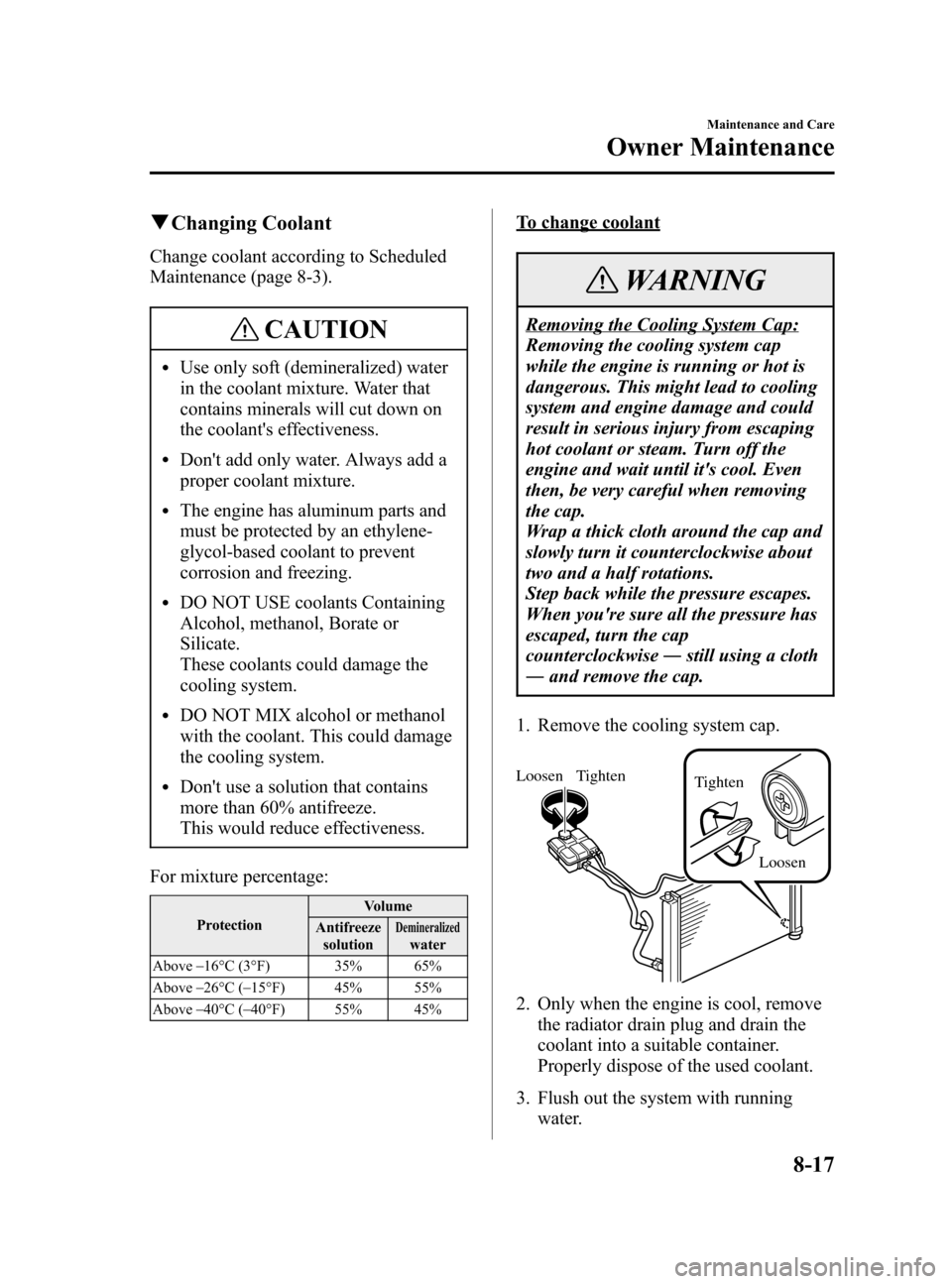
Black plate (247,1)
qChanging Coolant
Change coolant according to Scheduled
Maintenance (page 8-3).
CAUTION
lUse only soft (demineralized) water
in the coolant mixture. Water that
contains minerals will cut down on
the coolant's effectiveness.
lDon't add only water. Always add a
proper coolant mixture.
lThe engine has aluminum parts and
must be protected by an ethylene-
glycol-based coolant to prevent
corrosion and freezing.
lDO NOT USE coolants Containing
Alcohol, methanol, Borate or
Silicate.
These coolants could damage the
cooling system.
lDO NOT MIX alcohol or methanol
with the coolant. This could damage
the cooling system.
lDon't use a solution that contains
more than 60% antifreeze.
This would reduce effectiveness.
For mixture percentage:
ProtectionVolume
Antifreeze
solutionDemineralizedwater
Above_
16°C (3°F) 35% 65%
Above_
26°C (_
15°F) 45% 55%
Above_
40°C (_
40°F) 55% 45%
To change coolant
WARNING
Removing the Cooling System Cap:
Removing the cooling system cap
while the engine is running or hot is
dangerous. This might lead to cooling
system and engine damage and could
result in serious injury from escaping
hot coolant or steam. Turn off the
engine and wait until it's cool. Even
then, be very careful when removing
the cap.
Wrap a thick cloth around the cap and
slowly turn it counterclockwise about
two and a half rotations.
Step back while the pressure escapes.
When you're sure all the pressure has
escaped, turn the cap
counterclockwise―still using a cloth
―and remove the cap.
1. Remove the cooling system cap.
Loosen
Loosen Tighten
Tighten
2. Only when the engine is cool, remove
the radiator drain plug and drain the
coolant into a suitable container.
Properly dispose of the used coolant.
3. Flush out the system with running
water.
Maintenance and Care
Owner Maintenance
8-17
Mazda3_8T97-EC-04J_Edition1 Page247
Saturday, September 25 2004 2:16 PM
Form No.8T97-EC-04J
Page 248 of 322

Black plate (248,1)
4. Drain the system completely. Insert and
tighten the plug. Add as much
ethylene-glycol-based coolant mixture
and water as necessary to provide
freezing and corrosion protection.
5. In extremely cold climates, add the
mixture percentage recommended in
the coolant mixture percentage table.
6. Run the engine at idle with the cooling
system cap off. Slowly add additional
coolant if necessary.
7. At this point, wait until the engine
reaches normal operating temperature;
then depress the accelerator two or
three times. Add more coolant, if
necessary, until the system is full.
8. Install the cooling system cap. Inspect
all connections for leaks. Inspect the
level in the coolant reservoir one more
time.Brake/Clutch Fluid
qInspecting Brake/Clutch Fluid
Level
The brakes and clutch draw fluid from the
same reservoir.
Inspect the fluid level in the reservoir
regularly. It should be kept at MAX.
The level normally drops with
accumulated distance, a condition
associated with wear of brake and clutch
linings. If it is excessively low, have the
brake/clutch system inspected by an
Authorized Mazda Dealer.
8-18
Maintenance and Care
Owner Maintenance
Mazda3_8T97-EC-04J_Edition1 Page248
Saturday, September 25 2004 2:16 PM
Form No.8T97-EC-04J
Page 313 of 322
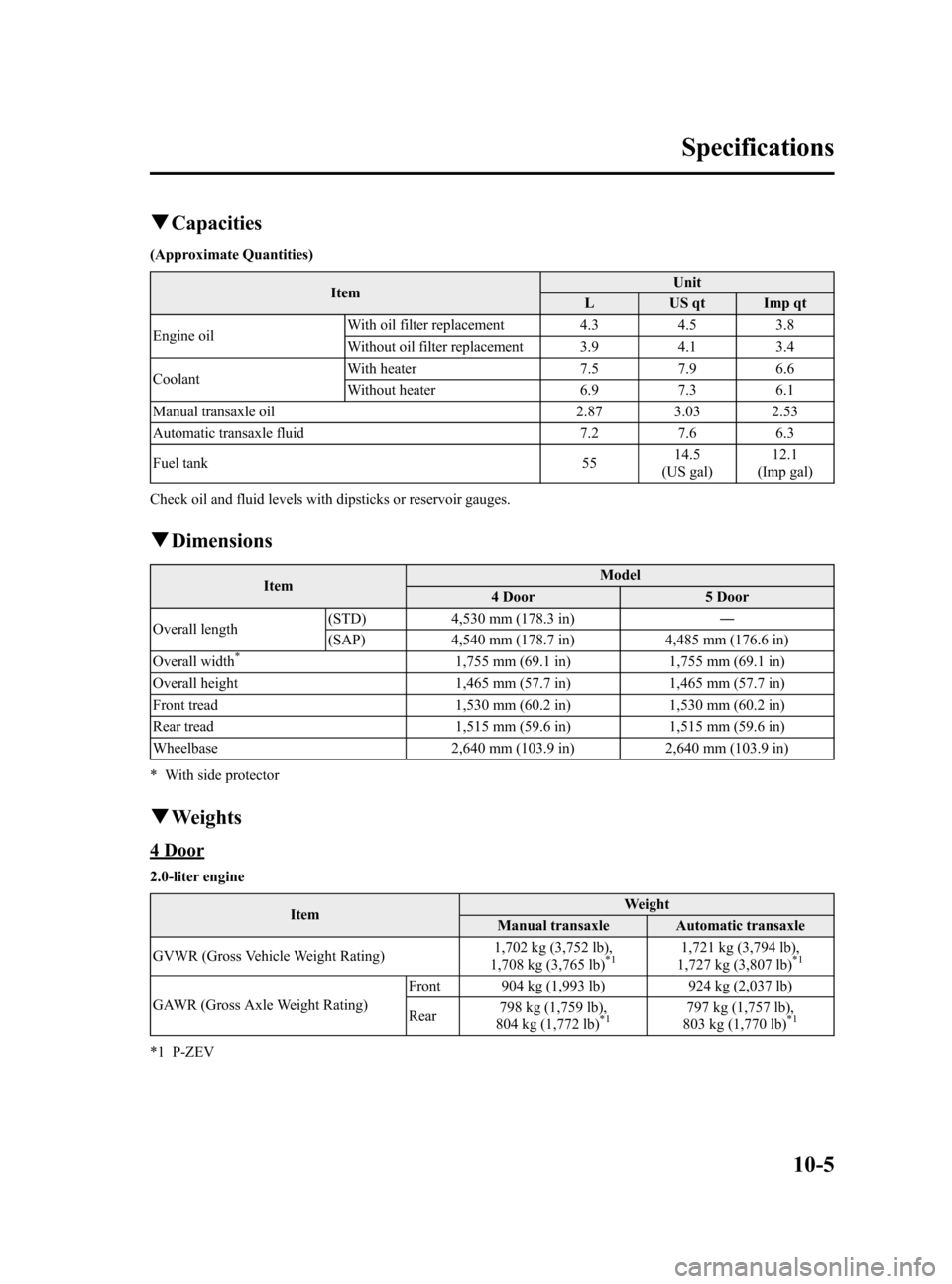
Black plate (313,1)
qCapacities
(Approximate Quantities)
ItemUnit
L US qt Imp qt
Engine oilWith oil filter replacement 4.3 4.5 3.8
Without oil filter replacement 3.9 4.1 3.4
CoolantWith heater 7.5 7.9 6.6
Without heater 6.9 7.3 6.1
Manual transaxle oil 2.87 3.03 2.53
Automatic transaxle fluid 7.2 7.6 6.3
Fuel tank 5514.5
(US gal)12.1
(Imp gal)
Check oil and fluid levels with dipsticks or reservoir gauges.
qDimensions
ItemModel
4 Door 5 Door
Overall length(STD) 4,530 mm (178.3 in)―
(SAP) 4,540 mm (178.7 in) 4,485 mm (176.6 in)
Overall width
*1,755 mm (69.1 in) 1,755 mm (69.1 in)
Overall height 1,465 mm (57.7 in) 1,465 mm (57.7 in)
Front tread 1,530 mm (60.2 in) 1,530 mm (60.2 in)
Rear tread 1,515 mm (59.6 in) 1,515 mm (59.6 in)
Wheelbase 2,640 mm (103.9 in) 2,640 mm (103.9 in)
* With side protector
qWeights
4 Door
2.0-liter engine
ItemWeight
Manual transaxle Automatic transaxle
GVWR (Gross Vehicle Weight Rating)1,702 kg (3,752 lb),
1,708 kg (3,765 lb)
*11,721 kg (3,794 lb),
1,727 kg (3,807 lb)*1
GAWR (Gross Axle Weight Rating)Front 904 kg (1,993 lb) 924 kg (2,037 lb)
Rear798 kg (1,759 lb),
804 kg (1,772 lb)*1797 kg (1,757 lb),
803 kg (1,770 lb)*1
*1 P-ZEV
Specifications
10-5
Mazda3_8T97-EC-04J_Edition1 Page313
Saturday, September 25 2004 2:17 PM
Form No.8T97-EC-04J
Page 319 of 322
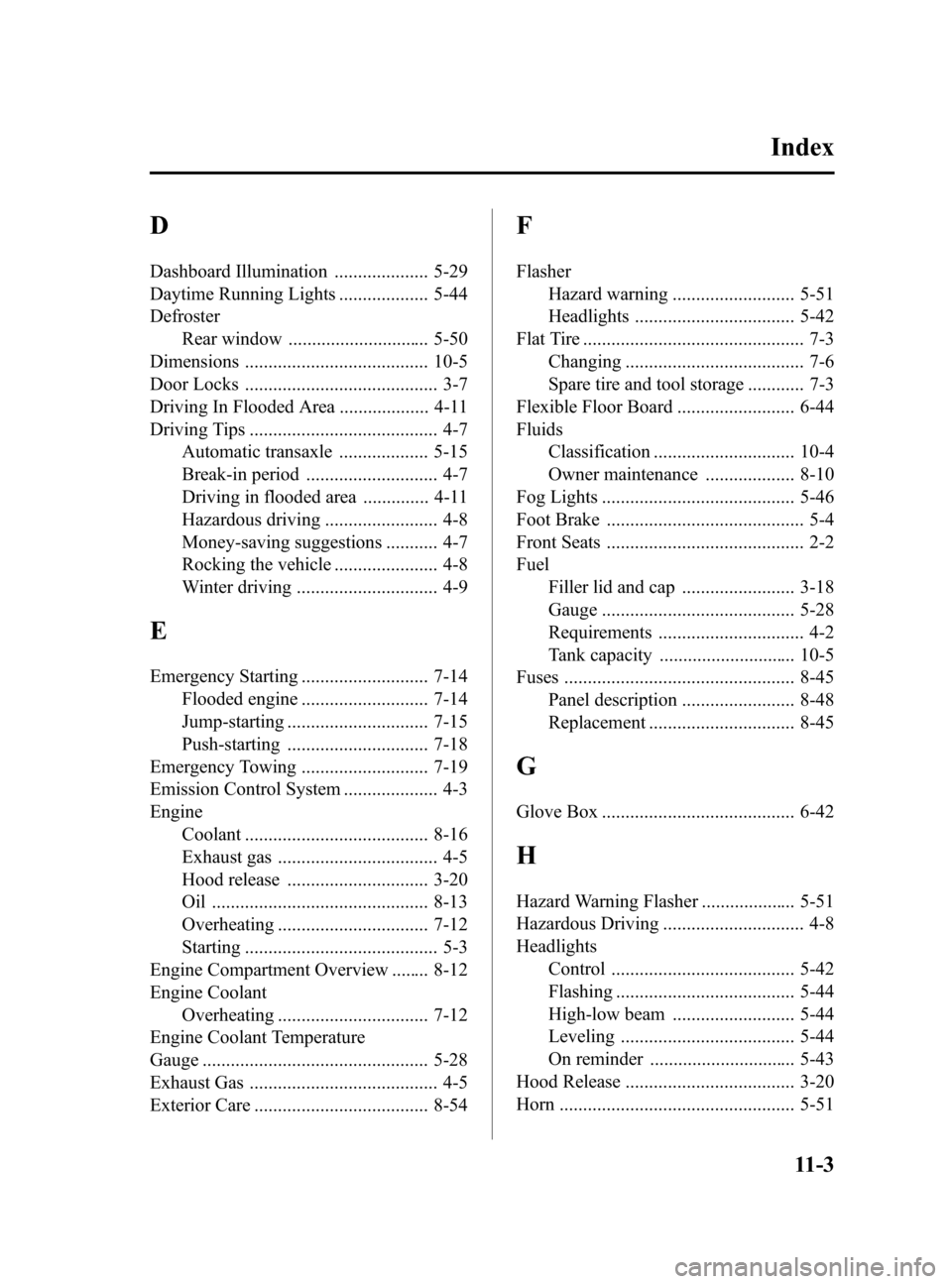
Black plate (319,1)
D
Dashboard Illumination .................... 5-29
Daytime Running Lights ................... 5-44
Defroster
Rear window .............................. 5-50
Dimensions ....................................... 10-5
Door Locks ......................................... 3-7
Driving In Flooded Area ................... 4-11
Driving Tips ........................................ 4-7
Automatic transaxle ................... 5-15
Break-in period ............................ 4-7
Driving in flooded area .............. 4-11
Hazardous driving ........................ 4-8
Money-saving suggestions ........... 4-7
Rocking the vehicle ...................... 4-8
Winter driving .............................. 4-9
E
Emergency Starting ........................... 7-14
Flooded engine ........................... 7-14
Jump-starting .............................. 7-15
Push-starting .............................. 7-18
Emergency Towing ........................... 7-19
Emission Control System .................... 4-3
Engine
Coolant ....................................... 8-16
Exhaust gas .................................. 4-5
Hood release .............................. 3-20
Oil .............................................. 8-13
Overheating ................................ 7-12
Starting ......................................... 5-3
Engine Compartment Overview ........ 8-12
Engine Coolant
Overheating ................................ 7-12
Engine Coolant Temperature
Gauge ................................................ 5-28
Exhaust Gas ........................................ 4-5
Exterior Care ..................................... 8-54
F
Flasher
Hazard warning .......................... 5-51
Headlights .................................. 5-42
Flat Tire ............................................... 7-3
Changing ...................................... 7-6
Spare tire and tool storage ............ 7-3
Flexible Floor Board ......................... 6-44
Fluids
Classification .............................. 10-4
Owner maintenance ................... 8-10
Fog Lights ......................................... 5-46
Foot Brake .......................................... 5-4
Front Seats .......................................... 2-2
Fuel
Filler lid and cap ........................ 3-18
Gauge ......................................... 5-28
Requirements ............................... 4-2
Tank capacity ............................. 10-5
Fuses ................................................. 8-45
Panel description ........................ 8-48
Replacement ............................... 8-45
G
Glove Box ......................................... 6-42
H
Hazard Warning Flasher .................... 5-51
Hazardous Driving .............................. 4-8
Headlights
Control ....................................... 5-42
Flashing ...................................... 5-44
High-low beam .......................... 5-44
Leveling ..................................... 5-44
On reminder ............................... 5-43
Hood Release .................................... 3-20
Horn .................................................. 5-51
Index
11-3
Mazda3_8T97-EC-04J_Edition1 Page319
Saturday, September 25 2004 2:17 PM
Form No.8T97-EC-04J